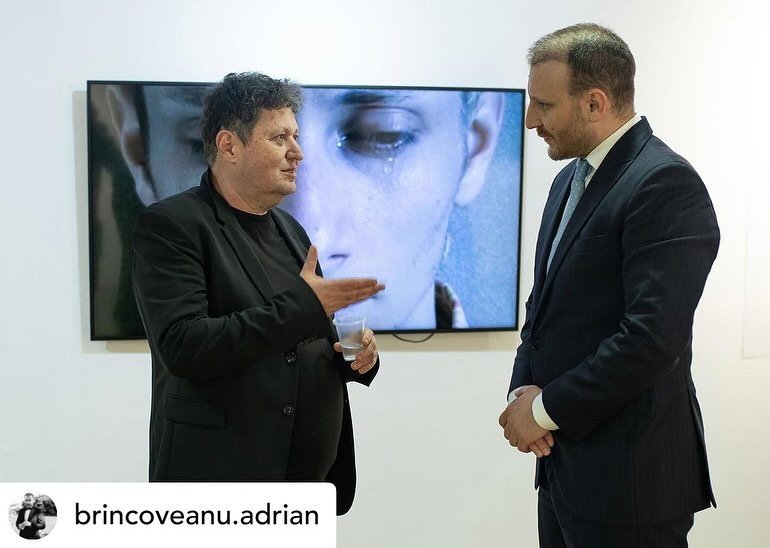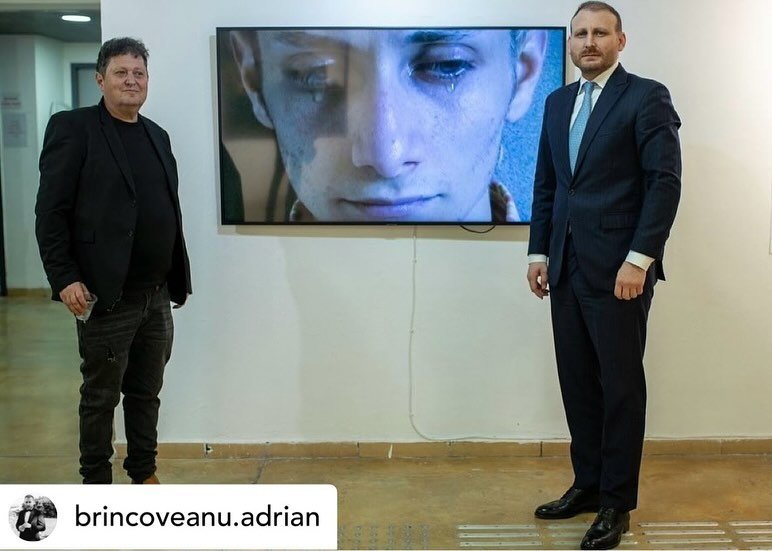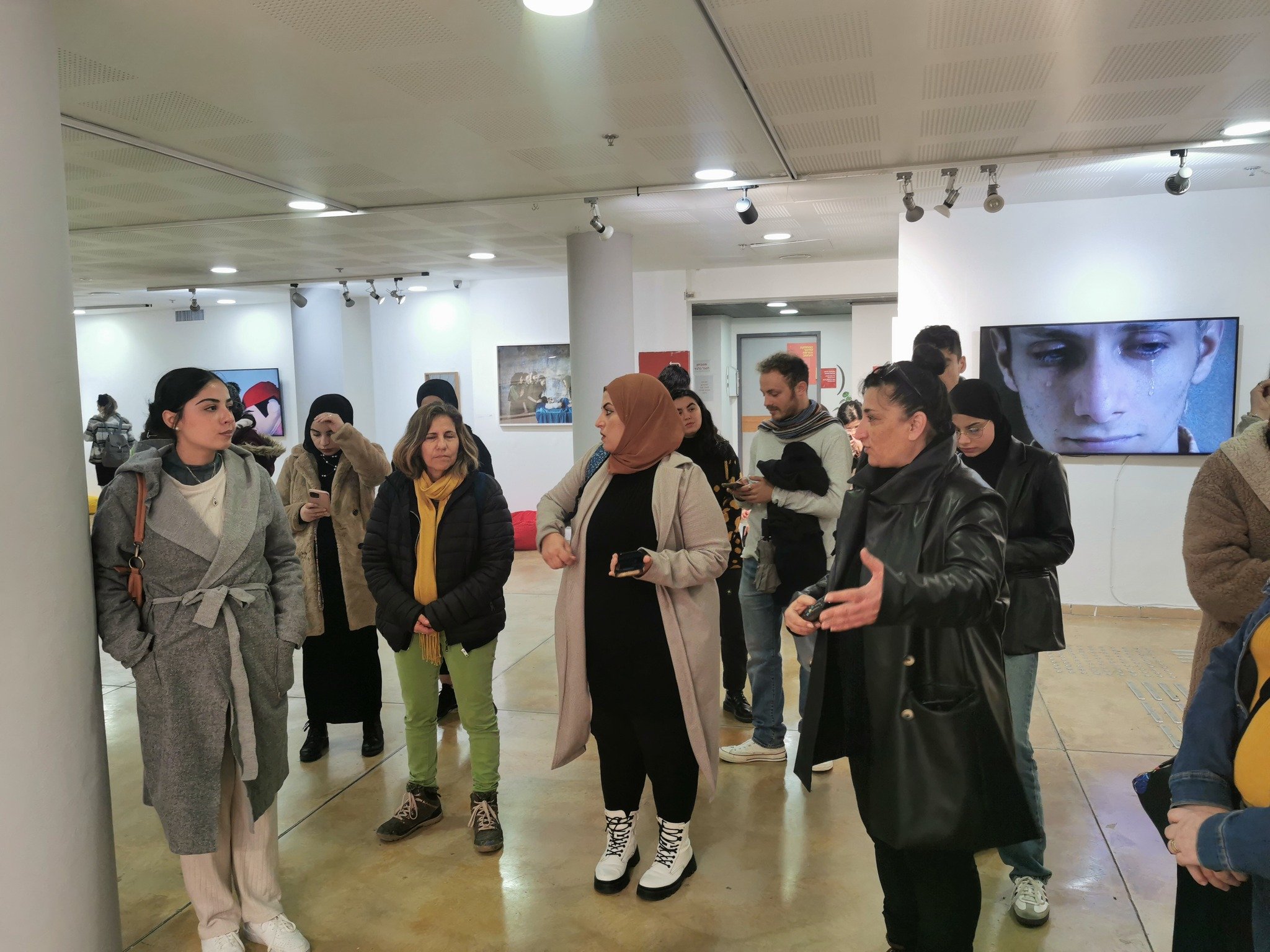[RO]
TRIUMF AMIRIA. Muzeul Culturii Queer [?], în parteneriat cu Muzeul Național de Artă Contemporană (MNAC), prezintă prima expoziție din seria Simți ~ Aluneci ~ Cânți (1- 245), în perioada 4 decembrie 2021 - 19 ianuarie 2022, la Combinatul Fondului Plastic (strada Băiculești 29, București).
Simți ~ Aluneci ~ Cânți (1- 245) include peste 100 de lucrări și serii produse de 38 de artiști/ artiste/ artistx și colective și este unul dintre rezultatele vizibile, în format de expoziție, ale cercetării despre practici artistice queer în România, în intervalul de 20 de ani de la un moment important în istoria politică recentă: decriminalizarea relațiilor între persoane de același sex odată cu abrogarea articolului 200 din Codul Penal, în 2001.
În bunul spirit fluid TRIUMF AMIRIA, duo-ul curatorial KILOBASE BUCHAREST – format din Dragoș Olea (de asemenea curator al secțiunii de arte vizuale Triumf Amiria) și Sandra Demetrescu, co-curatoare a expoziției și chief curator MNAC, – a selectat lucrări produse de artiști care se identifică queer, lucrări care abordează teme queer sau lucrări realizate într-o cheie critică, sau cu intenția de a pune în mișcare procese de schimbare.
Expoziția se poate decoda în nenumărate feluri:
*) un puzzle multidimensional în care coexistă și plutesc în dialog aproximativ 245 de scene narative queer în care dragostea, empatia și spiritul critic sunt ridicate la putere hiperbolică
*) un forum absolut necesar ~ fragil ~ prețios în continuă reformulare în care granițele între spațiul public (agora) și cel privat se topesc și se reiterează succesiv datorită lucrărilor și datorită unei arhitecturi de expoziție aventuroase ~ magice ~ surprinzătoare realizate împreună cu arhitecta Laura Paraschiv / CIRCA 1703 -3071
*) o retrospectivă nonlineară așteptată ~ neașteptată ~ imersivă a două decenii de producție artistică queer, în care temele nu au fost impuse de un grid preformatat, ci s-au ridicat la suprafață progresiv, în urma cercetării în profunzime și a discuțiilor cu artiștii.
*) o celebrare fără festivisme în care ești invitat să simți ~ aluneci ~ cânți printr-un repertoriu vast de expresii artistice queer despre identitate, dorință, traumă, ecologie, ritualuri și vindecare, viitor în cele mai progresiste forme, diferență, stigmatizare, rasism, sistemul artei contemporane, recuperarea spațiului public, dezmembrarea definițiilor și a normelor opresive, limbaj și neologismele unui vocabular extins, fluiditate, generozitate.
Procesul de documentare și producție a fost intens – accelerat ~ complex ~ entuziasmant, dar și epuizant, pe alocuri. Curatorii au avut de consultat, citit și procesat nenumărate portofolii, site-uri, materiale de presă din media culturală, materiale video și interviuri online cu artiștii, dar și discuții cu aceștia. La explorarea peisajului media care a scris despre practici queer în cele două decenii incluse în cercetare au participat și câțiva studenți voluntari de la Centrul de Excelență în Studiul Imaginii (CESI).
„Coagularea unei expoziții sau, mai precis spus, al unui set de expoziții într-o stare „in-between” – fluidă, miria-narativă și tentaculară, precum SIMȚI ~ ALUNECI ~ CÂNȚI – a presupus lucrul în profunzime cu mai multe comunități artistice, fiind ghidați la tot pasul de mai multe întrebări: cine sunt, sau trebuie să fie, artiștii invitați având în vedere că bugetul inițial includea 30 de poziții artistice? Cum putem să prezentăm în expoziție un spectru cât mai generos, nuanțat și surprinzător de lucrări despre subiecte queer și procese artistice de queering / „queerificare”? Cum să menținem o balanță constructivă între voci care au contribuit consistent la discursuri queer în România, dar și internațional, în cele două decenii cuprinse în cercetare, precum și voci emergente, între numeroase expresii de gen etc”, explică membrii Kilobase Bucharest.
TRIUMF AMIRIA. Muzeul Culturii Queer [?] este un proiect de recuperare a producției culturale queer din ultimii 20 de ani care se axează pe trei direcții: literatură, arte vizuale și arte performative, realizat de Asociația MozaiQ în parteneriat cu Muzeul Național al Literaturii Române, Muzeul Național de Artă Contemporană, Centrul de Teatru Educațional Replika și artista Kjertsi Vetterstad (Norvegia). Proiectul propune, de-a lungul anului 2021, o serie de evenimente menite a sublinia importanța culturii queer în ultimele decenii, dar și a încuraja producția culturală nouă prin expoziții, ateliere, tururi ghidate, spectacole de teatru și performance-uri, lecturi publice și evenimente de networking.
[EN]
TRIUMF AMIRIA. The Museum of Queer Culture [?], in partnership with the National Museum of Contemporary Art (MNAC Bucharest), present the first exhibition in the series You Feel ~ And Drift ~ And Sing (1- 245), which includes over 100 artworks and series produced by 38 artists/artistx and collectives and is one of the visible results, in exhibition format, of research on queer artistic practices in Romania, in the 20 years since an important moment in the recent political history: the decriminalisation of same-sex relationships with the repeal of Article 200 of the Criminal Code in 2001.
In the good fluid spirit of TRIUMF AMIRIA, the curatorial duo KILOBASE BUCHAREST - comprised of Dragoș Olea (also curator of the Triumf Amiria visual arts section) and Sandra Demetrescu, co-curator of the exhibition and chief curator of MNAC Bucharest, - have selected artworks produced by artists who identify as queer, works that address queer themes or that were made in a critical key, or with the intention of setting processes of change in motion.
The exhibition can be decoded in numerous ways:
*) a multidimensional puzzle in which some 245 queer narrative scenes coexist and float in dialogue in which love, empathy and critical spirit are raised to hyperbolic power
*) an absolutely necessary ~ fragile ~ precious forum in constant reformulation in which the boundaries between the public (agora) and the private space melt and are successively reiterated due to the works and to an adventurous ~ magical ~ surprising exhibition architecture created with the architect Laura Paraschiv / CIRCA 1703 -3071
*) an expected ~ unexpected ~ immersive non-linear retrospective of two decades of queer artistic production, in which themes were not imposed by a pre-formed grid, but rose to the surface progressively, following in-depth research and discussions with artists.
*) a celebration without festivities in which you are invited to feel ~ drift ~ sing through a vast repertoire of queer artistic expressions about identity, desire, trauma, ecology, ritual and healing, the future in its most progressive forms, difference, stigma, racism, the contemporary art system, reclaiming public space, dismantling oppressive definitions and norms, language and the neologisms of an expanded vocabulary, fluidity, generosity.
The process of documentation and production has been intense - accelerated ~ complex ~ exciting, but also exhausting at times. The curators had to consult, read and process countless portfolios, websites, cultural media press materials, videos and online interviews with artists, as well as conversations with them. Several student volunteers from the Center for Excellence in the Study of the Image (CESI) participated in the exploration of the media landscape that reported on queer practices over the two decades included in the research.
"The coalescence of an exhibition or, more accurately, a set of exhibitions into an «in-between» state - fluid, myriad-narrative and sprawling, like YOU FEEL ~ AND DRIFT ~ AND SING - involved working in depth with several artistic communities, being guided at every step by several questions: who are, or should be, the invited artists given that the initial budget included 30 artistic positions? How can we present a generous, nuanced and surprising spectrum of work on queer subjects and queering/queer artistic processes in the exhibition? How can we maintain a constructive balance between voices that have consistently contributed to queer discourses in Romania, as well as internationally, in the two decades covered by the research, as well as emerging voices, among numerous gender expressions, etc", explain the members of Kilobase Bucharest.
TRIUMF AMIRIA. The Museum of Queer Culture [?] is a recuperation project of queer cultural production from the last 20 years focusing on three directions: literature, visual arts and performing arts, carried out by the MozaiQ Association in partnership with the National Museum of Romanian Literature, the National Museum of Contemporary Art, the Replika Educational Theatre Centre and the artist Kjertsi Vetterstad (Norway). Throughout 2021, the project proposes a series of events aimed at highlighting the importance of queer culture over the last decades, as well as encouraging new cultural production through exhibitions, workshops, guided tours, theatre performances, public readings and networking events.
[photo credit: Serioja Bocsok]
























